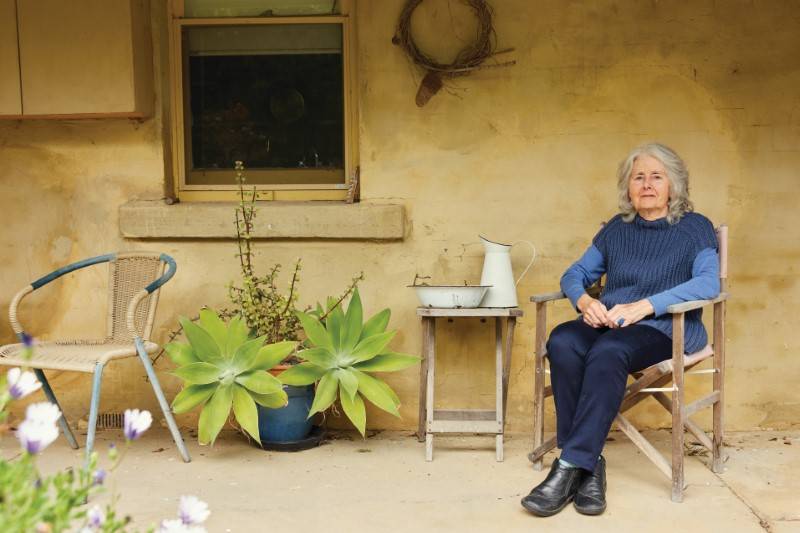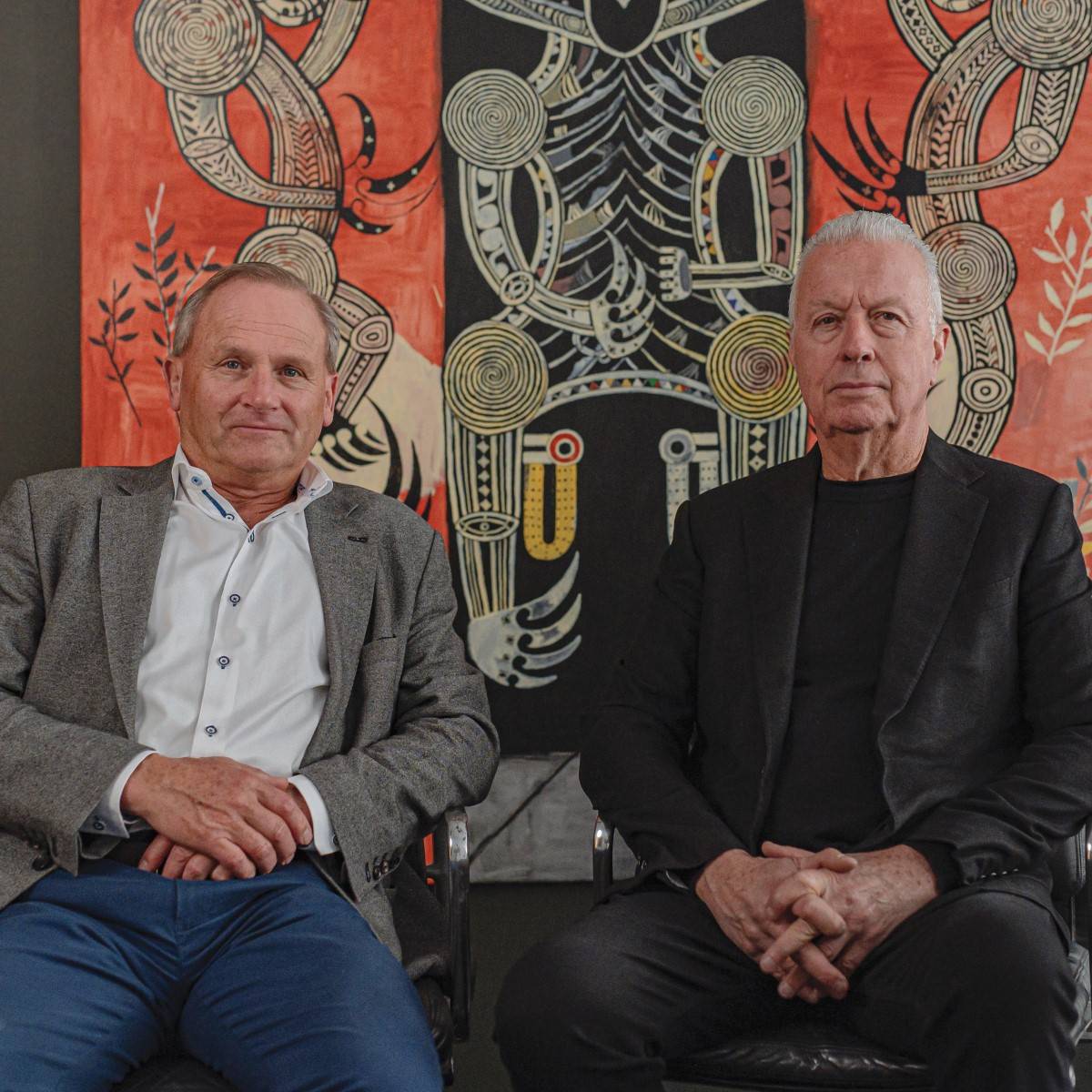Wendy Stavrianos: Some Ancient Wisdom
For Wendy Stavrianos, exploring a psychological connection between nature, body and mind has sometimes been political, but mostly philosophical.
Words: Anne Marsh
Photography: Brian Doherty
When I emailed Wendy Stavrianos about this article asking for explanations from her that would assist an understanding of her practice over several decades, she began by saying, “throughout my practice I engage with the metaphysical”. The works present an abstract and poetic exploration of psychological states of mind in relation to the experiences and representations of the body and nature. She writes: “Tracks through the landscape, threads that connect / Tracks through the body, inside and outside / Veins and arteries, roads and byways / City lines of communication and movement / Ruptures in the web of life.”
A contemporary artist who focuses on the landscape she experiences and inhabits, Stavrianos has a deep empathy for nature and understands the ontology – the living being of the natural environment. She describes herself as a humble gatherer who collects materials during her daily bush walks to include in her work. Images of gatherers recur in her sculptures, installations and paintings from the 1990s to the present.
In her recent exhibitions, the windows of her studio, an old sheering shed, provide a visual framing of her gatherings which she draws and paints. The translucent windows stream light but they do not allow a focussed view of the outside, which she says she would find distracting. Speaking of her upcoming exhibition Connecting Threads at Nicholas Thompson Gallery, Melbourne, she says, “My current work takes from my studio the gathering matter and the remains that I have collected from harsh summers on Mt Gaspard.”
“They are placed against the light from my studio window. The works emphasise a linear, reinvestigation of drawing through the figure in the landscape on canvas… They are not narrative pictures. This means I can become the forms and make a metaphysical reality of my own. This also gives freedom to the viewer to reach deeply into their own imagination.”
Stavrianos’ practice is contemporary and experimental but don’t be surprised to find classical and mythological references. The conceptual depth is in the layering and framing of imagery. Her dexterity as an artist is based on fine drawing skills and a strong painterly approach which is seen in museum-sized paintings, sometimes incorporating fabrics and found materials, etchings, drawings and installations.
In her late works where the studio window frames symbols, metaphors and imaginations, the artist brings her love for the metaphysical to the fore. “Sometimes I approach my work as a stage set,” she says. “I saw Giotto’s work in Italy… in the 1960s, these had a profound effect on my art then and now. The stage from Giotto re-surfaces in a spared down form in the works named Place or Room. Here I am seeking to connect with a metaphysical space in the work. In these other realities I have been attempting to delve into the mystery and wonder of the universe. Through these spaces that I inhabit as an art maker, I try to interact with environmental concerns that are so urgent today.”
Stavrianos’ provenance in the artworld is well established. Writer Laura Murray Cree wrote the large format monograph titled Wendy Stavrianos in 1997. The book has great colour reproductions of the paintings of the 1980s and 90s and the big installation works.
Some of these are in major state and regional collections, others in private collections in Australia, Europe and the USA. But I suspect some are still available through Nicholas Thompson Gallery or via the auction houses. The book also has a range of full page black and white reproductions, including works on paper.
One of her major works Mungo Lovers (Rape of the Land), 1986-7 was not purchased until 2021. It is a shame that the painting was not purchased earlier by an Australian museum but so often these opportunities are missed by our institutions.
The sale of Mungo Lovers (Rape of the Land) is a good indicator that Stavrianos’ big paintings from the 1990s that explore the anamorphic and mythological relations between body, psyche and nature are talking loudly to an environmentally conscious international market.
Demonstrating her empathy with the natural environment, Stavrianos told Tiarney Miekus in a 2020 podcast for Art Guide Australia that, “in the early days I could hardly contain the emotion while I was painting. I was almost in agony because it was so felt and I still feel those feelings now”.
Darwin in the 1970s represented a major turning point in the artist’s practice. It was here that she fully explored how the earth had been wounded. Rape of a Northern Land, 1976-8 is a large fabric sculptural drawing with lines sewn across its uneven surface. The work depicts the desolate, ransacked environment after uranium mining in Rum Jungle. Talking about this place to Miekus she said, “I could feel the energies there, it was so negative in that country, and that was my first realisation that land can be used in a political way. To be absolutely destroyed… It was a very strong moment in my lifetime.” Stavrianos said she later found out that the area was a sacred site for Aboriginal women.
Celebration of Woman, 1977-78 was destroyed by the young artist because of the criticism she received. She says, “it was the suggested sexual content that offended them, because the lily shapes were three dimensional in the way they were sewn.” Shortly after this she got a call from the South Australian Film Commission requesting permission to reproduce the work in a film. Luckily, a detail from the work is illustrated in Murray Cree’s book.
Rape of a Northern Land is in the artist’s collection. It would be a significant work to collect, given the controversy over its cousin Celebration of Woman.
NICHOLAS THOMPSON
Director, Nicholas Thompson Gallery, Melbourne
“I have been familiar with the work of Wendy Stavrianos since I was a student, largely from reading Australian art books and magazines. I was always struck by the powerful and romantic imagery in her work and the broad references to the surrealist, metaphysical and environmental art movements of the 20th century. I was thrilled to meet her in person in 2016 and quickly invited to her join my gallery.
“The forthcoming exhibition Connecting Threads will be our fourth, following previous shows of retrospective and current work. It has been an exciting time to work with Wendy as her career is being reassessed. She has been included in Anne Marsh’s 2021 publication Doing Feminism as well as several Australian and international articles and her work has been acquired by the Queensland Art Gallery/Gallery of Modern Art and the Art Gallery of New South Wales in recent years.
“Having exhibited since the late 1960s, Wendy has a loyal following in Melbourne and among artists, art historians and writers. Several of her works are typically acquired from each exhibition, and a large significant work of Wendy’s from the 1980s was purchased by an international collector in 2019. The work in the forthcoming exhibition will be smaller accessible works on paper and will thematically continue her concerns with climate change.
“Her work resonates strongly with followers of art history as well as contemporary art, along with anyone concerned with the environmental destruction continually inflicted by humans on the planet.”
SASHA GRISHIN
Art historian, critic and writer
“[I first came across Wendy Stavrianos’ work] in the 1980s, when I was head of the Department of Art History at the ANU and the senior art critic for the local paper. I encountered her work in a number of exhibitions and was deeply moved by its power, mastery and intensity.
“Stavrianos is rare in her visual literacy, what she says in her work you feel intuitively – spiritually – not verbally. She seems to tap into some ancient wisdom, dark and unresolved, like snippets of dreams from her childhood, yet she manages to translate it into a universal language that resonates with the viewer. She also possesses a very impressive skill set as a painter.
“In a number of ways, Stavrianos has been ahead of the pack and frequently after reading the latest French critical theory have critics realised that she has been doing this decades earlier.
“Stavrianos has been in it for the long haul, consistent, unfashionable and frequently working under the radar of popular acclaim. She is one of our major artists and the power of her work will inevitably thrust her into the pantheon of significant Australian artists.”
This article was originally published in Art Collector issue 106, October-December 2023.













